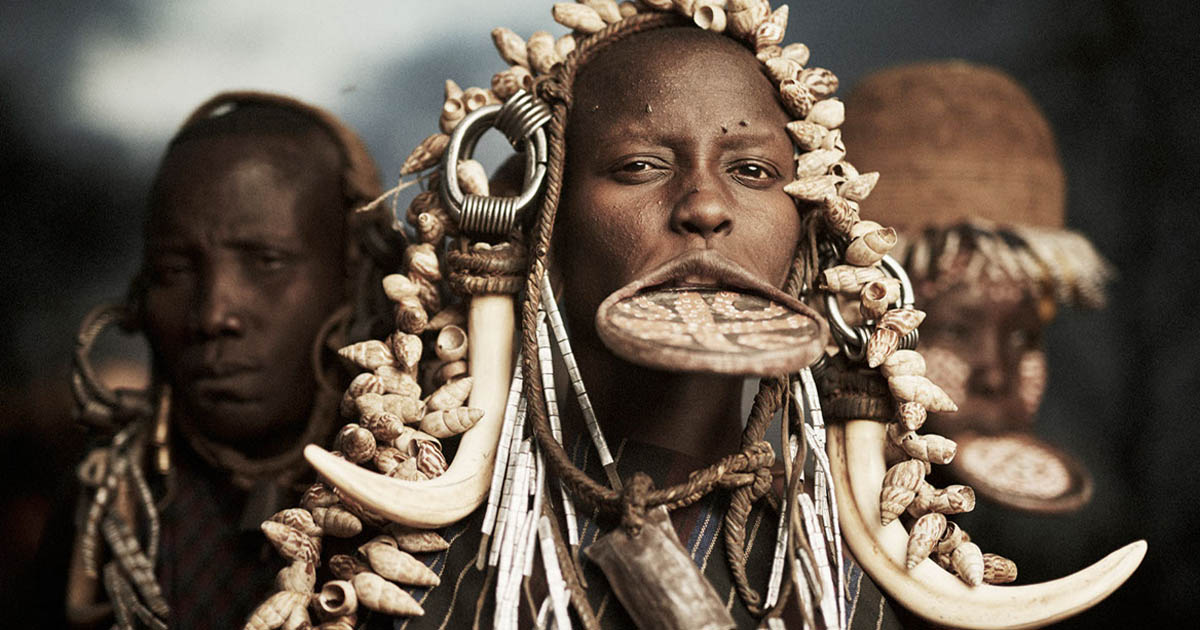Mursi Tribe, Ethiopia
Ethiopia is a nature-lovers paradise, known for being home to numerous species found nowhere else in the world. Tourists love this destination for the dramatic scenery, rich biodiversity, and one particularly dangerous spectacle: The Mursi Tribe.
Tourists from around the world travel to Ethiopia specifically to get up-close-and-personal with this physically intriguing tribe. However, the Mursi take immense pride in their land, and they protect it at all costs.
Armed and aggressive, the Mursi are known as “the most dangerous tribe in East Africa”. So, why are people so eager to see them?

Where They Live
The Mursi Tribe lives in the far southwest corner of Ethiopia, just north of the Kenyan border. They live among the valley of the River Omo—a remote area where paleontologists have discovered some of the oldest human remains on Earth.
Surrounded by mountains, their home is one of the most isolated regions of the country. Bryan_T, Flickr
Bryan_T, Flickr
Who They Are
There are less than 10,000 members of the Mursi tribe. They are part of the Surmic ethnic group of Ethiopia.
Their neighbors include the Aari, the Banna, the Mekan, the Karo, the Kwegu, the Nyangatom and the Suri. They are grouped together with the Me'en and Kwegu by the Ethiopian government under the name Surma. hakanyalicn, Shutterstock
hakanyalicn, Shutterstock
Their Culture & Religion
The Mursi speak the Mursi language.
They are semi-nomadic pastoralists (cattle farmers) that regularly move around the region wherever water sources are most beneficial for their cattle.
The Mursi believe that they experience a force greater than themselves, which they call Tumwi. This entity is usually located up in the sky, but sometimes it can manifest itself as an object in the sky, such as a rainbow or a bird. hecke61, Shutterstock
hecke61, Shutterstock
Their Culture & Religion
There is one person, referred to as the Komoru, who acts as a means of communication between the community and the Tumwi.
Communication is especially important in times of need, such as when the community is threatened by drought, crop pests and disease.
The Komoru perfoms dances and rituals, and typically does not leave his tribal region. Yury Birukov, Shutterstock
Yury Birukov, Shutterstock
Their Culture & Religion
The Mursi religion is classified as Animism: the belief that objects, places and creatures all possess a distinctive spiritual essence.
Though some Mursi people have more recently adopted Christianity beliefs. Luciana Boccazzi, Shutterstock
Luciana Boccazzi, Shutterstock
Rites of Passage: Lip Plates
The Mursi endure various rites of passage.
Lip plates are a well-known part of the Mursi culture. They are one of the last groups in Africa whose women still wear large pottery, wooden discs, or plates in their lower lips.
This custom is linked to the female’s fertility and eligibility for marriage.
When a Mursi girl reaches puberty—around the age of 15 or 16—another female member of the tribe will cut her lip and insert a small wooden stick.
The small stick is replaced each night by a larger stick to slowly stretch the hole. Eventually, they change the stick to plates and other decoration.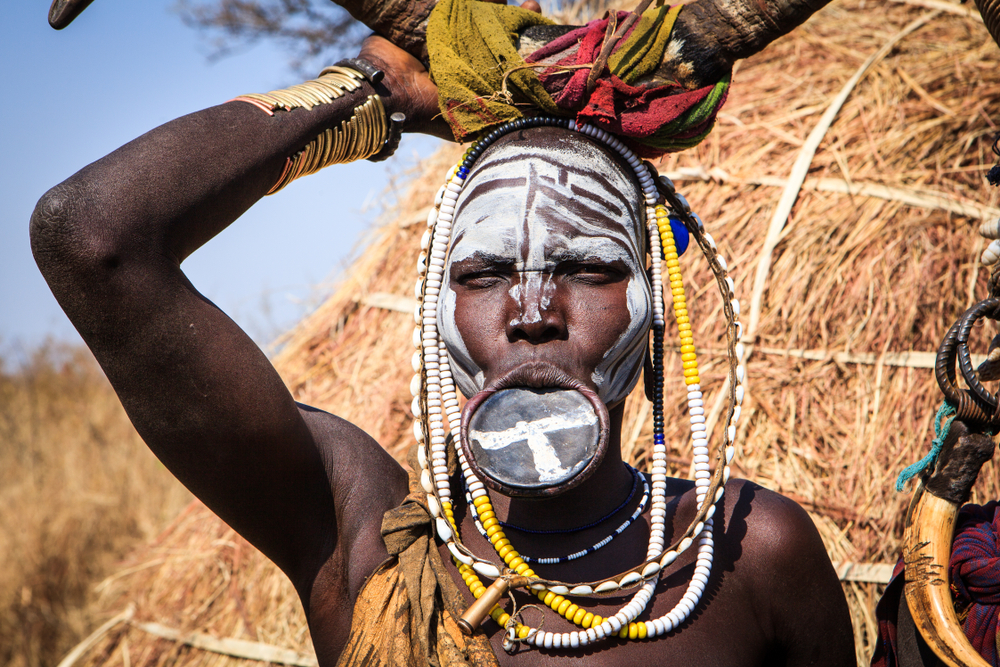 Anya Newrcha, Shutterstock
Anya Newrcha, Shutterstock
Rites of Passage: Lip Plates
Mursi women who do not wear lip plates are considered lazy. It is also believed that women without lip plates will not bring as big of a bridal dowry as those who do have lip plates. Dowries are usually a certain number of cattle.
Some lip plates can reach up to 12cm in diameter—marking perseverance and bravery on behalf of the woman who wears it.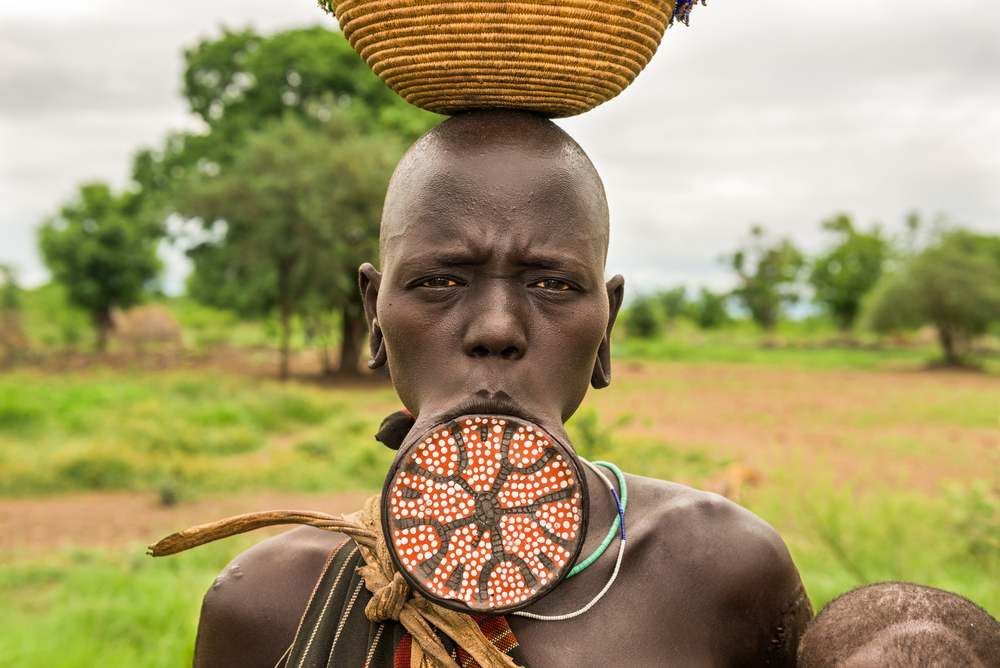 Nick Fox, Shutterstock
Nick Fox, Shutterstock
Rites of Passage: Lip Plates
Lip plates are made from wood or clay. They are mostly worn by single or newly married women, and usually during four main occasions: while serving food to men, at special events (like weddings), ceremonial duels, and dances.
The woman may slowly stop wearing it after a number of years of marriage, or when her husband passes away. Andrzej Kubik, Shutterstock
Andrzej Kubik, Shutterstock
Rites of Passage: Donga
One of the main rites of passage for men is ceremonial dueling called donga. The Mursi men must prove themselves to their future wives by taking part in a duel against another man.
The men wear a dueling kit called a umonga, made from animals skins, which offers protection and decoration.
The men duel using wooden poles that are 2 meters long until one retires or is knocked out. erichon, Shutterstock
erichon, Shutterstock
Symbolic Art
Another common tradition for the Mursi is body painting. They paint their bodies using clay and minerals from the Earth.
The body paint is said to ward off evil spirits, intimidate enemies, and attract the opposite gender.
The clay also acts as a sun protectant and the white limestone acts as an insect repellant, making it a practical practice as well. Nick Fox, Shutterstock
Nick Fox, Shutterstock
Tribal Wealth
A Mursi man’s wealth is measured by the size of his cattle herd. Cattle are a vital element of the Mursi diet, as well as trade.
Aside from being used for food, the cattle are also traded for grain during periods of weak crops—particularly during seasons of low rainfall and drought.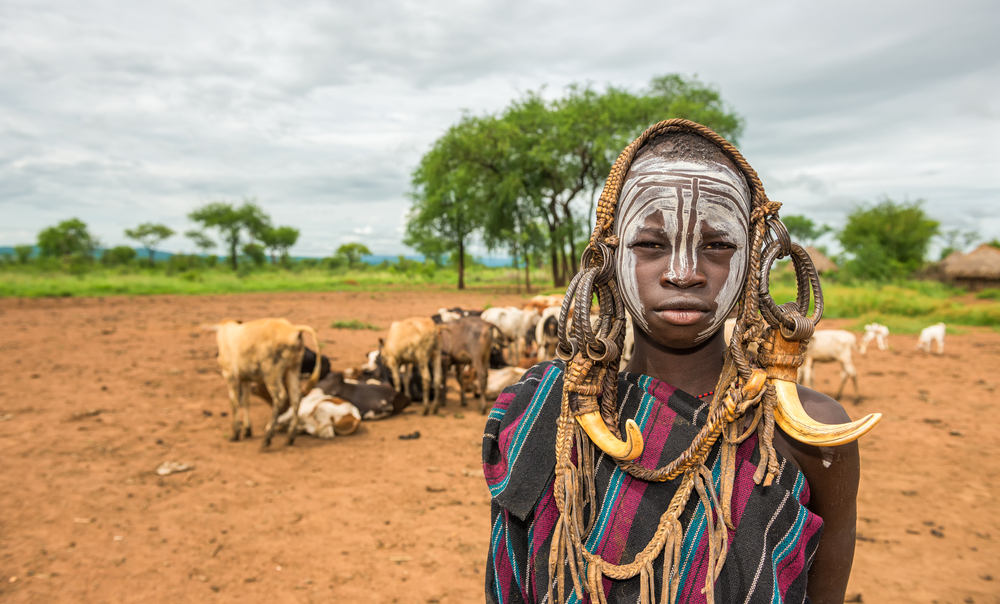 Nick Fox, Shutterstock
Nick Fox, Shutterstock
Tribal Conflict
The Mursi often face conflict with other tribes, particularly due to the scarcity of water. Because of this, the Mursi tribe stays heavily armed.
Many of the male leaders carry AK-47s to protect the tribe from wild hyenas, boars, and cattle thieves—as well as anyone who may pose a threat.
This is how they gained the title of “most dangerous tribe in East Africa”. Aleksandra Kossowska, Shutterstock
Aleksandra Kossowska, Shutterstock
Income Source: Tourism
The Mursi are not considered “uncontacted”. They choose to live where they do, and how they do. They are very much aware of the outside world.
In fact, they use their unique way of life as a source of income from nosey tourists who travel far distances to come and take pictures of them.
The Mursi keep permanent villages along the main road where they know tourists will come to see them. The women know to have their lip plates in place and get dressed up for their photos.
Tourists often bring gifts, clothing, supplies, food, and money for the tribe in exchange for taking their photos and gawking at them for hours. Andrzej Kubik, Shutterstock
Andrzej Kubik, Shutterstock
Income Source: Tourism
After exploiting themselves, Mursi women will attempt to sell unused lip plates to tourists.
During slow times of tourism (such as during the pandemic), Mursi tribespeople would aggressively rush at any tourists who showed up, in a fight between each other for the goods that may be available to them.
This obviously deters tourists, and the Mursi suit up in protective gear to fight each other for what they may have received. Dave Primov, Shutterstock
Dave Primov, Shutterstock
Sustaining Their Way of Life
The truth of the matter is, the Mursi people have learned that if they participate in the tourism gimmick, they will earn money and be able to afford things they otherwise would not have access to, such as medicine, special tools, and defenses.
They do not typically wear their lip plates and colorful decorations while at home, unless there is a special event. They only dress up when their photo will be taken—like a job. Matyas Rehak, Shutterstock
Matyas Rehak, Shutterstock
Sustaining Their Way of Life
Most of the money earned gets dispersed among the immediate community in that location—meaning whoever went to that area for that reason.
Most of the tribe live deep within the bush, sustaining their way of life with minimal modern input. They raise cattle, grow crops and wear minimal clothing.
The tribe members who mostly remain unseen are protected by armed Mursi leaders who patrol their territory and keep watch of the tourists. Luisa Puccini, Shutterstock
Luisa Puccini, Shutterstock
Rights to Their Land
The African Parks Foundation and government park officials have been accused of coercing the Mursi (and other tribes in the area) into giving up their land without any compensation.
African Parks has taken over their land and are working on completing documents that will label the Mursi as unlawful squatters (on their own land) and they will be forcefully removed.
Several human rights activists have become involved over the years. Oscar Espinosa, Shutterstock
Oscar Espinosa, Shutterstock
Access to Their Land
Aside from the legal troubles, another major challenge for the Mursi tribe comes from a hydroelectric dam that was built in 2015 in the Basin of the Omo. The Mursi tribe relied heavily on the lower basin for their livelihood.
Further irrigation systems are in process, which will also significantly impact the African tribes living in these areas, essentially pushing them out of their own lands.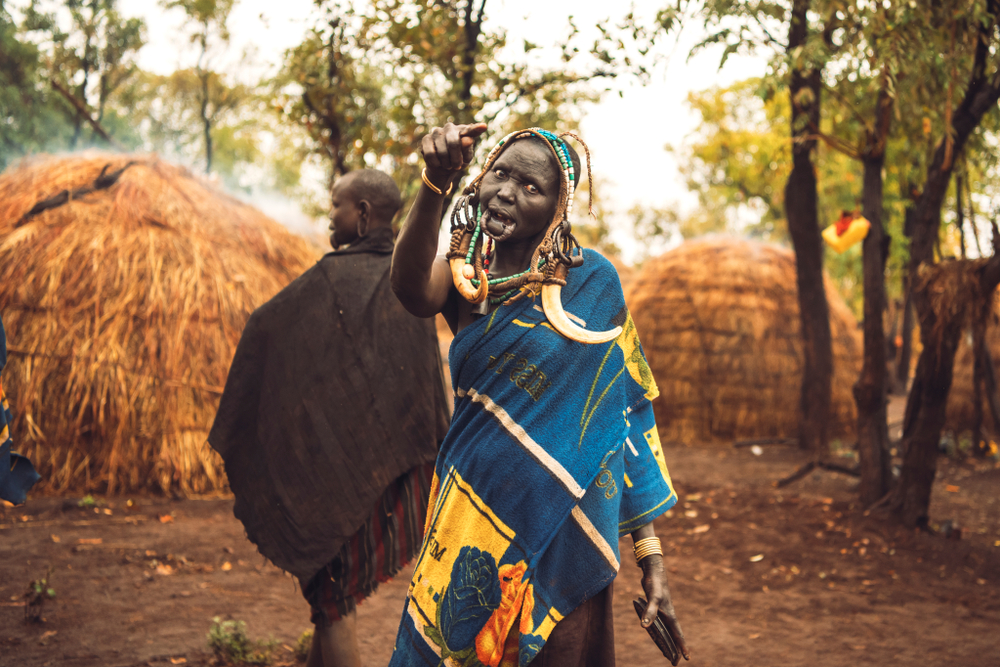 klublu, Shutterstock
klublu, Shutterstock
Final Thoughts
The Mursi Tribe thrives in the dense Ethiopian forest, living a semi-nomadic lifestyle rich in tradition. They are aware of the outside world and choose to remain living in isolation, showing their faces only as a desperate source of income.
The tribe is heavily guarded and known to react immediately with force to anyone perceived as a threat, giving them the reputation of the most dangerous tribe in East Africa.  Ilia Torlin, Shutterstock
Ilia Torlin, Shutterstock

